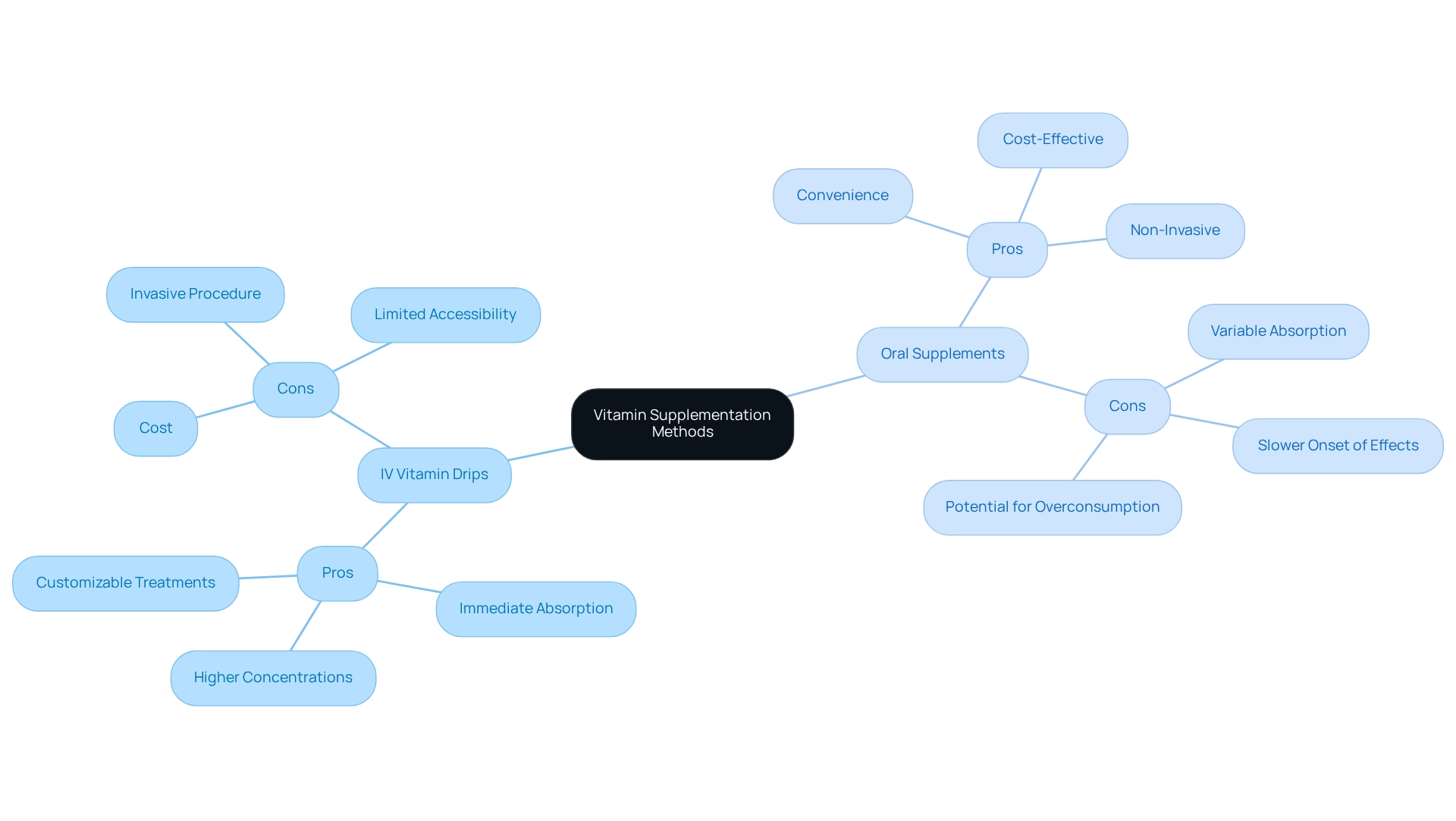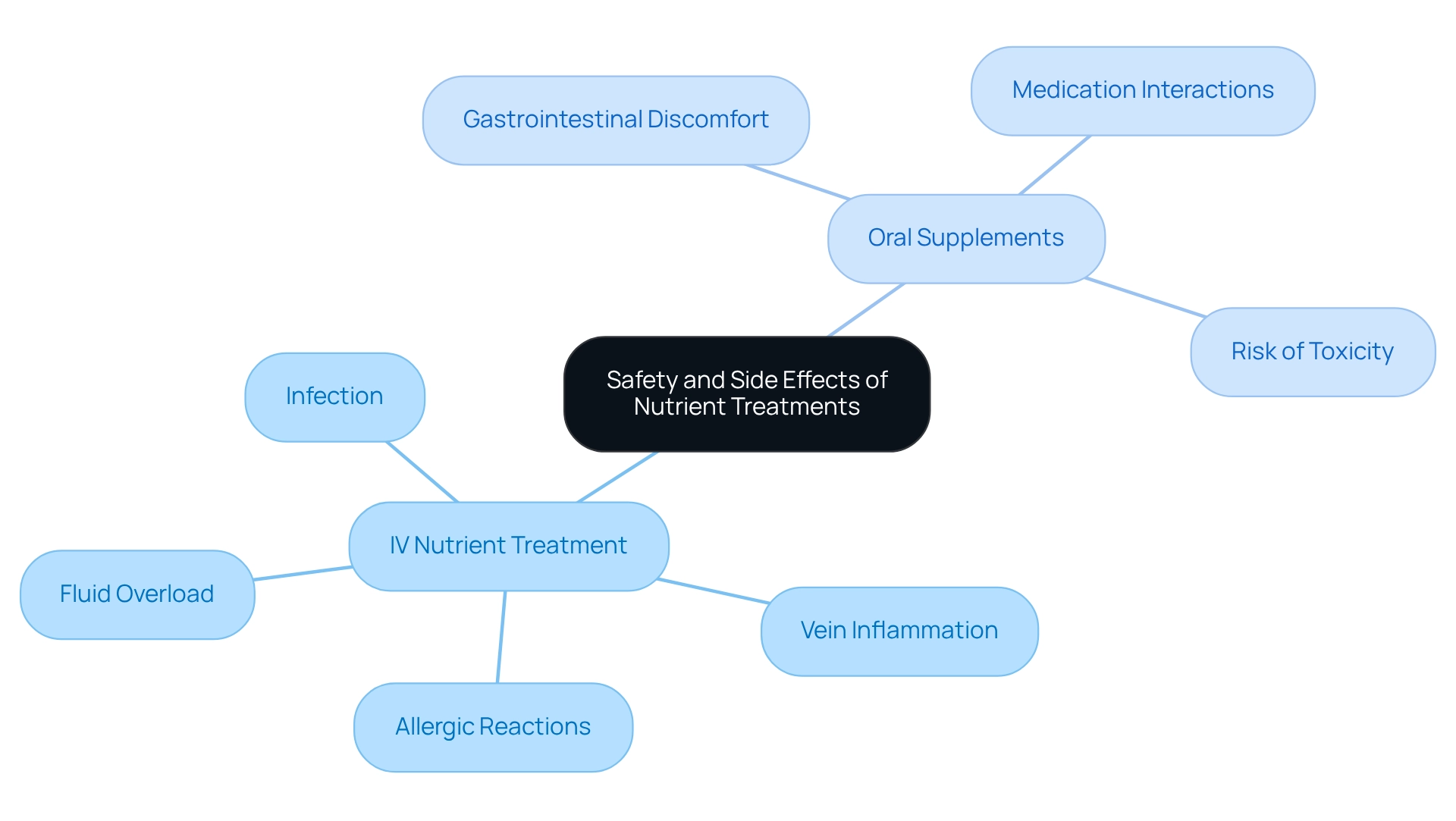Do IV Vitamin Drips Work? Comparing Effectiveness with Oral Supplements
Overview
IV vitamin drips offer a remarkable advantage over oral supplements, primarily due to their nearly 100% absorption rate. By delivering nutrients directly into the bloodstream, they effectively bypass the digestive system, ensuring that the body receives the maximum benefit. This article underscores the significant absorption disparities between these two methods, emphasizing that customized IV treatments can provide targeted health benefits that conventional oral supplements may not achieve.
Furthermore, the evidence presented highlights how these tailored IV treatments cater to individual health needs, making them a compelling option for those seeking specific outcomes. As a result, individuals may find that IV vitamin drips not only enhance their nutrient intake but also support their overall health in ways that oral supplements cannot.
In conclusion, exploring the potential of IV vitamin drips could lead to improved health outcomes. For those interested in optimizing their wellness, investigating further into these treatments may prove beneficial.
Introduction
In the quest for optimal health, individuals often find themselves at a crossroads: should they opt for the rapid nutrient delivery of IV vitamin drips or the convenience of oral supplements? With a growing interest in wellness therapies, understanding the nuances between these two methods becomes essential.
IV vitamin therapy boasts nearly 100% absorption rates, effectively bypassing the digestive system’s hurdles. In contrast, oral supplements face challenges that can diminish their effectiveness.
As the market expands, it’s crucial to weigh the benefits and drawbacks of each approach, considering factors such as:
- Cost
- Safety
- Individual health needs
This exploration sheds light on the efficacy of both IV drips and oral supplements, empowering readers to make informed decisions about their wellness journeys.
Understanding IV Vitamin Drips and Oral Supplements
IV nutrient drips deliver essential nutrients and minerals directly into the bloodstream, allowing for immediate absorption and utilization by the body. This method bypasses the digestive system, which can often limit nutrient bioavailability. In contrast, dietary supplements must traverse the gastrointestinal tract, where they are broken down and absorbed. This process can lead to variable absorption rates, typically ranging from 10% to 50%, influenced by factors such as the specific nutrient and individual digestive health.
For instance, while oral B12 supplementation is prevalent, studies indicate it does not significantly enhance cognitive function or prevent cognitive decline in older adults. This underscores the need for further research into its effectiveness. A prolonged follow-up of the B-PROOF trial revealed that after a median of 54 months, the intervention had no impact on cardiovascular disease (CVD) risk, highlighting the importance of assessing the long-term efficacy of nutrient treatments.
The growing market for IV nutrient therapies reflects an increasing interest in wellness services, making it essential to understand do IV vitamin drips work when evaluating the effectiveness of each approach in delivering vital nutrients. Always consult with your healthcare provider before altering your wellness regimen. Recognizing the advantages and disadvantages of both IV nutrient infusions and dietary supplements is crucial for making informed health decisions.
Effectiveness: Comparing Nutrient Delivery
In the discussion regarding the efficacy of IV nutrient drips compared to other forms, many ask do IV vitamin drips work, as IV therapy is often acknowledged for its enhanced bioavailability. Research shows that IV administration can achieve nearly 100% absorption of nutrients, as they are delivered directly into the bloodstream, bypassing the digestive system. In contrast, oral supplements often encounter obstacles such as degradation in the gastrointestinal tract and competition with other nutrients, leading to significantly lower absorption rates. For example, this nutrient taken orally may only be absorbed at rates varying from 20% to 30%. This notable disparity in absorption highlights the benefits of IV treatment, particularly for individuals with specific nutrient deficiencies or those requiring rapid replenishment of vitamins and minerals.
Furthermore, the ability to customize IV treatments allows for targeted health interventions, enhancing their therapeutic potential. IV treatment not only revitalizes cell membranes, protects the liver, detoxifies, and supports brain, heart, and lipid metabolism, but it also has practical applications in athletic recovery. Athletes gain advantages from athletic recovery IV treatment for quicker recuperation following intense workouts or races.
Case studies have demonstrated that specific components in IV drips, such as amino acids and minerals, can positively influence cardiovascular health by regulating blood pressure and improving overall wellness. As highlighted by AZ IV Medics, “Whether you require hydration, immunity, recovery, or performance assistance, AZ IV Medics’ mobile IV service delivers the highest-quality nutrients directly to you — with superior absorption assured.” As the most recent studies keep investigating whether do IV vitamin drips work, it becomes more evident that for some individuals, IV drips may provide a more efficient option for nutrient delivery than conventional pills.
Pros and Cons of IV Vitamin Drips vs. Oral Supplements
Pros and Cons of IV Vitamin Drips vs. Oral Supplements
IV Vitamin Drips
Pros:
- Immediate Absorption: Nutrients are delivered directly into the bloodstream, ensuring rapid availability for the body.
- Higher Concentrations: Intravenous treatment can provide significantly larger doses of vitamins and minerals compared to oral supplements, which may enhance therapeutic effects.
- Customizable Treatments: IV infusions can be adjusted to satisfy personal health requirements, enabling specific nutrient blends that address particular deficiencies or health objectives. As mentioned, ‘Your IV Package Can Be Altered To Meet Certain Requirements,’ emphasizing the customized approach of IV treatment.
Cons:
- Cost: The expense of IV therapy can be a barrier, with sessions typically ranging from $100 to $500, making it a less feasible option for regular use. In contrast, dietary additions typically range from $10 to $50 monthly, making them a more economical option.
- Invasive Procedure: The need for needle insertion can lead to discomfort and carries risks such as infection or other complications.
- Limited Accessibility: IV treatment is not as commonly accessible as pills, often necessitating trips to specialized clinics.
Oral Supplements
Pros:
- Convenience: Oral supplements are easy to take and widely available in various forms, including pills, gummies, and powders, making them accessible for daily use.
- Cost-Effective: Typically, pills are more affordable than IV therapy, enabling regular intake without considerable financial burden.
- Non-Invasive: There are no needles or medical procedures involved, making dietary additions a more comfortable choice for many individuals.
Cons:
- Variable Absorption: Nutrient absorption from oral supplements can be inconsistent due to digestive factors, which may limit their effectiveness.
- Slower Onset of Effects: Users may experience a delayed response in terms of health benefits compared to the immediate effects of intravenous treatment.
- Potential for Overconsumption: There is a risk of individuals taking excessive amounts of certain nutrients or minerals without realizing it, which can lead to toxicity and adverse health effects.
In a 2009 study investigating the Myer’s cocktail—a high-dose mixture of nutrients and minerals—participants with fibromyalgia reported considerable enhancements in pain and quality of life after undergoing IV treatment for eight weeks. However, the placebo group also demonstrated significant progress, emphasizing the ambiguity regarding the true efficacy of IV treatment. In general, the decision of whether to choose IV vitamin drips or dietary additions depends on personal health requirements, financial considerations, and preferences, particularly when considering do IV vitamin drips work. While IV treatment offers rapid and customizable nutrient delivery, oral supplements provide a more convenient and cost-effective alternative. Significantly, North America represented 46.82% of the IV hydration treatment market share in 2022, suggesting its increasing popularity.

Safety and Side Effects: What to Consider
IV nutrient treatment is broadly considered safe when administered by qualified experts; however, it is not without its hazards. Common side effects associated with IV nutrient drips raise the question of do IV vitamin drips work, and these side effects include:
- Infection at the injection site
- Vein inflammation or irritation
- Allergic reactions to the infused substances
- Fluid overload, which can pose serious complications for individuals with certain health conditions.
In 2025, safety concerns surrounding IV nutrient drips have prompted discussions among health professionals, emphasizing the need for careful administration and monitoring. For instance, while some services offer at-home IV nutrient therapy, this convenience comes with inherent risks that should be approached with caution. Dr. Offit has highlighted the importance of disclosing the use of dietary aids to healthcare providers, as certain aids can interfere with medical treatments.
Conversely, ingestible aids present a different array of risks. Possible side effects include:
- Gastrointestinal discomfort, such as nausea or diarrhea
- Interactions with medications, especially when taken in large amounts
- Risk of toxicity from fat-soluble nutrients (A, D, E, K) if ingested in excess.
Statistics indicate that adverse reactions to dietary additions are common, with reports underscoring real-world cases of toxicity and interactions that can jeopardize health. For example, harmful levels of certain nutrients can lead to significant vision alterations, underscoring the necessity of monitoring intake of additional substances. This connection between toxicity and adverse reactions highlights the importance of caution when evaluating oral supplements, as one might wonder do IV vitamin drips work, and both IV nutrient administration and oral supplements require careful assessment of personal health conditions and potential interactions with other treatments. IV administration allows for quicker access to fluids, medications, and nutrients via the circulatory system, which can be beneficial for certain individuals but may pose risks for others. It is highly advisable to seek guidance from a healthcare professional before starting any new supplementation plan, ensuring that individuals make informed decisions tailored to their health needs. Moreover, IV therapy has gained popularity in the beauty sector for its ability to rejuvenate skin by delivering nutrients directly into the body. While this can effectively address common skin issues like acne and dullness, it is essential to remain aware of the potential risks associated with its use. In summary, both IV nutrient treatment and oral supplements necessitate careful consideration and professional guidance to ensure safety and effectiveness.

Cost Analysis: IV Vitamin Drips vs. Oral Supplements
The price of intravenous nutrient treatment varies significantly based on factors such as the clinic, specific substances included, and geographic location. Typically, prices range from $150 to $500 per session, with premium treatments potentially exceeding this range. Notably, IV packages can be customized to meet specific requirements, such as adding B12 for individuals who are vitamin B12 deficient. Regrettably, insurance coverage for these therapies is often limited or nonexistent, resulting in substantial out-of-pocket expenses for many individuals.
Conversely, pills present a more budget-friendly option. A month’s supply of multivitamins can cost between $10 and $50, depending on the brand and formulation. This affordability makes dietary aids a more accessible choice for regular use, particularly for those on a budget. However, it is crucial to recognize that total expenses can accumulate, especially if multiple supplements are needed to meet specific nutrient needs, leading many to ask, do IV vitamin drips work better despite imposing a greater financial burden compared to oral supplements? The latter, while more economical, may require consistent use to achieve similar effects. Additionally, individuals should consider the risk of nutrient excess and other potential side effects associated with IV treatment, such as phlebitis, which refers to vein inflammation that may occur if the IV catheter remains in place for extended periods. Alan Gaby notes that excessive levels of certain nutrients can lead to changes in vision. Moreover, case studies have indicated that while exploring whether do IV vitamin drips work, they can result in serious side effects, highlighting the importance of careful monitoring and informed decision-making regarding nutrient intake.

Conclusion
The comparison between IV vitamin drips and oral supplements reveals significant differences in nutrient delivery methods.
IV vitamin therapy is recognized for its nearly 100% absorption rate, providing immediate access to essential vitamins and minerals. In contrast, oral supplements often experience variable absorption due to digestive processes. This distinction is crucial for individuals facing specific nutrient deficiencies or those seeking rapid replenishment.
While IV therapy offers benefits such as higher concentrations and customizable treatments, it is accompanied by higher costs and potential side effects related to invasive procedures. On the other hand, oral supplements are more accessible and cost-effective but may require consistent use to achieve optimal benefits. Additionally, there is a risk of variable absorption and potential toxicity from excessive intake.
Ultimately, the choice between IV vitamin drips and oral supplements should be guided by individual health needs, budget considerations, and personal preferences. Consulting with a healthcare provider is essential to navigate these options safely and effectively. This ensures that personal wellness journeys are informed and tailored to specific requirements. Understanding the strengths and limitations of both methods empowers individuals to make educated decisions that align with their health goals.
Frequently Asked Questions
What are IV nutrient drips and how do they work?
IV nutrient drips deliver essential nutrients and minerals directly into the bloodstream, allowing for immediate absorption and utilization by the body. This method bypasses the digestive system, which can limit nutrient bioavailability.
How does the absorption of nutrients differ between IV drips and dietary supplements?
IV administration can achieve nearly 100% absorption of nutrients as they are delivered directly into the bloodstream, while oral supplements typically have absorption rates ranging from 10% to 50%, influenced by factors like the specific nutrient and individual digestive health.
What are some limitations of oral supplements?
Oral supplements must traverse the gastrointestinal tract, where they can be degraded and compete with other nutrients, leading to significantly lower absorption rates. For example, oral B12 supplementation may only be absorbed at rates of 20% to 30%.
What does research say about the effectiveness of oral B12 supplementation?
Studies indicate that oral B12 supplementation does not significantly enhance cognitive function or prevent cognitive decline in older adults, highlighting the need for further research into its effectiveness.
What are the potential benefits of IV nutrient therapies?
IV nutrient therapies can provide targeted health interventions, support athletic recovery, detoxify the body, and improve cardiovascular health by regulating blood pressure and enhancing overall wellness.
How can IV treatments be customized?
IV treatments can be tailored to address specific nutrient deficiencies or health needs, allowing for personalized health interventions.
What should individuals consider before using IV nutrient drips?
It is essential to consult with a healthcare provider before altering any wellness regimen, as understanding the advantages and disadvantages of both IV nutrient infusions and dietary supplements is crucial for informed health decisions.
Are there any practical applications of IV nutrient therapy for athletes?
Yes, athletes can benefit from IV nutrient therapy for quicker recovery following intense workouts or races, as it helps replenish vitamins and minerals rapidly.






